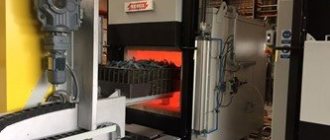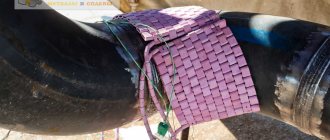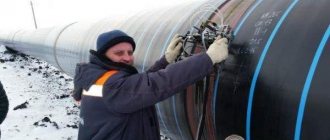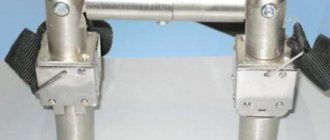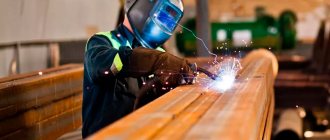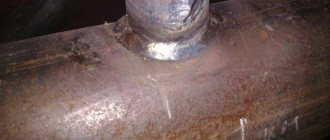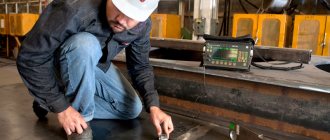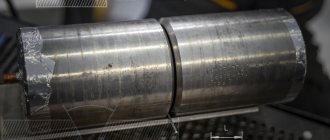A new line of induction heaters (6th generation) has been launched. The entire SWP model range has been updated:
- - medium-frequency induction heaters (MF) with an operating frequency of 6-10 kHz;
- — high-frequency induction heaters (HF) with an operating frequency of 15-30, 30-60 or 50-120 kHz.
Medium-frequency induction heaters are designed for metal melting and forge heating of workpieces starting from a diameter of 50 mm. Low frequency allows you to heat the workpiece evenly throughout the entire volume.
High-frequency induction heaters allow you to perform induction soldering, induction (forging) through heating of workpieces and hardening of parts to a depth of 3-5 mm (if a special hardening transformer is available). HF installations are most often used in scanning hardening and make it possible to achieve a hardening layer 1-2 mm thick. Also, high-frequency induction units can be used for soldering or desoldering of carbide alloys.
The SWP line of induction heaters has switched to new modern four-layer control boards. HDTV installations are known for their sensitivity to operating conditions and require certain operating experience. The new board eliminates errors that may be made when working with the installation. It monitors all operating parameters, including input voltage/current, coolant temperature and inductor short circuit, allowing the unit to be shut down in time without burning out the internal electronics. New IGBT modules of the KT series are also used.
All installations have a touch screen. This innovation expands the capabilities of the induction installation and allows for external control (4-20 mA, 0-10 V, 0-5 V, RS485), connecting external pyrometers and thermocouples. The touch screen also allows you to program the unit to operate in different modes. The new design of the case has an air machine and an emergency shutdown button for the unit. Additional forced air cooling of the case was added.
Updated induction heaters are already available for order.
- High Frequency Induction Heaters (HF Series)
- Medium frequency induction heaters (SS Series)
INDUCTION HEATER is an electric heater that operates by changing the flux of magnetic induction in a closed conductive circuit. This phenomenon is called electromagnetic induction. Want to know how an induction heater works? ZAVODRR is a trade information portal where you will find information about heaters.
Vortex induction heaters
An induction coil is capable of heating any metal, heaters are assembled using transistors and have a high efficiency of more than 95%; they have long replaced lamp induction heaters, whose efficiency did not exceed 60%.
A vortex induction heater for non-contact heating has no losses in adjusting the resonant coincidence of the operating parameters of the installation with the parameters of the output oscillatory circuit. Vortex-type heaters assembled on transistors are able to perfectly analyze and adjust the output frequency in automatic mode.
Homemade steps
Making such a device yourself is not that difficult. For this you will need:
- Make a heating element.
- Make an inductor coil from copper wire.
- Take a ready-made alternator.
- Connect the heater with the coil to the heating system.
- Connect the coil to the generator.
- Connect power to the system.
- Make a test run to check the operation of the unit.
In industrial models, a metal pipe with thick walls is used as a heater, but providing sufficient power to a homemade device to heat such an element is very difficult and does not make much sense. The induction coil is capable of heating any metal, so the heater can be modified.
Industrial models of induction boilers are equipped with a heating element made of a thick metal pipe. It is difficult to copy such a unit at home
A piece of plastic pipe is used as a housing for an induction heater from a welding inverter. It should be slightly larger in diameter than the heating pipes. The length of the heater pipe can be approximately one meter, the internal diameter can vary between 50-80 mm.
To connect the heater to the system, adapters should be installed in the lower and upper parts of the housing. The lower part of the pipe must be covered with a grill, then a filler consisting of small metal particles is placed inside the body. You can get the filler, for example, from wire, rod, narrow metal pipe, etc.
The length of the segments can be varied arbitrarily. Most often, steel wire with a diameter of 6-8 mm is used for this, which is simply cut into small pieces. Some craftsmen recommend cutting it into long rods, about 90 cm, i.e. almost along the length of the heater.
For the body of the heating element of an induction boiler, which you made yourself, you will need a wide, about 50 mm in diameter, plastic pipe
The higher the magnetic resistance of the steel from which the wire is made, the better it will heat up. Depending on the size of these pieces, a protective mesh is selected, which is mounted at the bottom of the housing. The filler is poured or placed in the pipe to the very top. After this, the upper part is also covered with a mesh.
The diagram allows you to get an idea of how to connect the induction coil to the boiler heater and to the welding machine
Thus, a homemade heater for an induction boiler looks like a thick plastic pipe stuffed with pieces of metal and closed on both sides with a mesh. The heater has adapters at the top and bottom for connection to the heating circuit. The polymer pipe for the heater must have fairly thick walls.
In addition, any plastic is not suitable for these purposes; the material must withstand the effects of fairly strong heat and at the same time not release any hazardous substances into the atmosphere or coolant. Now you need to make an induction grill. To do this, take copper wire and wind it directly onto the heater body.
Some models of homemade induction heaters use a narrow copper tube instead of a plastic pipe. This is not the best option, since it will not be easy to correctly roll such an element into a spiral.
The more turns of wire, the better. It is believed that the induction coil must have at least 90 turns. The inductor is wound onto the pipe very tightly; there should be no gap between the turns.
A 1-1.5 mm insulated copper wire is suitable for the winding. A thicker cable is not needed here, since it will complicate the winding work and it will be more difficult to position the turns closely.
This diagram will help to correctly connect the inductor coil to the inverter welding machine; if done incorrectly, the coil will turn into an electromagnet (+)
The presence of gaps can lead to noise due to the vibration that accompanies the operation of such a unit. Over time, this situation can lead to the destruction of the insulation, which will cause an interturn short circuit.
In addition to the adapters, shut-off valves should be installed at the top and bottom. They are needed to provide the ability, if necessary, to shut off the water in the heating circuit.
When installing the heater, remember that its lower end must be directed towards the return pipe, a pipe designed to collect cooled coolant in a two-pipe heating system. The easiest way to get an alternating field generator is to take an inverter from a welding machine.
The contacts of the induction coil are connected to the poles of the inverter. As soon as power is supplied to the unit and it is turned on, the homemade induction boiler will begin to work.
To make such a device, even an inexpensive welding machine is suitable, for example, a Chinese-made model, which allows you to regulate the current strength, starting from a level of 10 A. A thermostat sensor should be installed near the adapter at the supply. The welding inverter is connected through this thermostat.
Rectifier diodes must be installed at the outputs. To do this, you will have to open the body of the welding machine and solder the conductors to the output, then connect them to the diodes. If you connect directly without diodes, then a current with a rectified voltage will flow to the winding, and the coil will work as an electromagnet, and not as an inductor.
To create an induction spiral, it is recommended to use copper wire with a cross-section of 1.5 mm in a reliable insulating sheath; you need to make about 90 turns
Some modern welding machines have a touch sensor that starts work the moment the electrode touches the work surface. This point must be taken into account so that the sensor either triggers at the right moment or does not affect the operation of the homemade boiler.
If an inexperienced craftsman has problems with altering a welding machine, it is better for him to seek professional advice.
To make an induction boiler with your own hands, you can take any welding machine with suitable characteristics. If necessary, the device can be used again for welding work.
If everything is done correctly, the welding machine can be used in the future for its intended purpose. It will be necessary to unsolder the conductors with the diodes and reassemble them. When exposed to high frequency alternating current, the induction coil will create a magnetic field.
The metal inside the polymer housing will begin to heat up and transfer heat to the water, which circulates through the heating circuit. The device will only take a few minutes to warm up the coolant.
The location for the induction heater should be chosen correctly. The unit should be located 800 mm below the ceiling level, and should be separated from walls and furniture by at least 300 mm.
Metal induction heaters
Heaters for induction heating of metal have a non-contact method due to the action of a vortex field. Different types of heaters penetrate the metal to a certain depth from 0.1 to 10 cm, depending on the selected frequency:
- high frequency;
- average frequency;
- ultra high frequency.
Induction metal heaters make it possible to process parts not only in open areas, but also to place heated objects in isolated chambers in which any environment, as well as a vacuum, can be created.
Large storage systems
We found out what the main disadvantage of the “pipe-in-pipe” water heating element is. Indirect heating takes too long. Since increasing heat transfer is difficult, you can use a larger container to heat water. Then you can “conjure” the heat exchanger. The best option in the illustration: a coil inside a wide body.
The design is a tank of the required capacity (50, 100, 200 liters), inside of which there is a coil (the longer, the more effective the heating). The heat source does not matter: usually it is the room heating circuit. The water in the sanitary (internal) tank warms up quite quickly. The only problem is the uneven distribution of heat. A “cold” area remains at the bottom of the container. Despite the correct selection of heated water (receiving pipe from above), the cold area does not allow the entire volume to warm up.
When making it yourself, it is recommended to use a stainless steel tank and a copper coil. The additional costs will be offset by the high efficiency of the system.
Moreover, materials are not in short supply. The tank will fit from an old activator-type washing machine. A copper tube is sold at any plumbing store.
Another option: “tank in tank”. If you are faced with the question of how to make a boiler with your own hands, take a closer look at this diagram.
The internal container (in which indirect heating will occur) is selected with corrugated walls (preferably). This means there is a larger heat exchange area. And the primary heating water flows through an external point. If you cooled a pan of hot compote in a bowl of cold water, the principle of operation of the heater is clear.
Of course, such a system is more difficult to implement, but the efficiency will be higher.
Electric Induction Heater
High frequency electric induction heater is gaining new applications every day. The heater operates on alternating electric current. Most often, induction electric heaters are used to bring metals to the required temperatures during the following operations: forging, soldering, welding, bending, hardening, etc. Electric induction heaters operate at a high frequency of 30-100 kHz and are used to heat various types of media and coolants.
Electric heater is used in many areas:
- metallurgical (HDTV heaters, induction furnaces);
- instrument making (soldering of elements);
- medical (production and disinfection of instruments);
- jewelry (jewelry manufacturing);
- housing and communal services (induction heating boilers);
- food (induction steam boilers).
Medium Frequency Induction Heaters
When deeper heating is required, medium-frequency type induction heaters are used, operating at medium frequencies from 1 to 20 kHz. Compact inductors for all types of heaters come in a variety of shapes, which are selected so as to ensure uniform heating of samples of the most varied shapes, while it is also possible to carry out specified local heating. The mid-frequency type will process materials for forging and hardening, as well as through heating for stamping.
Easy to operate, with efficiency up to 100%, induction mid-frequency heaters are used for a wide range of technologies in metallurgy (also for melting various metals), mechanical engineering, instrument making and other fields.
- Induction heater 15 kW Moscow
- Induction heater 60 kW Perm
- Induction heater 80 kW Ekaterinburg
- Induction heaters 120 kW Ekaterinburg
Application:
- mechanical engineering industry
- metalworking industry
- melting of ferrous and non-ferrous metals
- deep heating of workpieces
- hot stamping
- hardening of metals to maximum depth
- hardening of crane wheels.
more details
Selecting a cable and machine
When renovating new apartments, the boiler is usually wired separately directly from the panel.
If you want to connect the boiler to the old common wiring, which already has several sockets connected, be sure to make sure that it can withstand the power of the boiler. In most cases, with a power of up to 3.5 kW, wiring must be done with a 3-core copper cable VVGnG-Ls, with a cross-section of at least 2.5 mm2.
The three-core cable is required to ensure a permanent connection to ground.
Choose a two-pole boiler connection machine. The rated current of the machine is 16A (sufficient for boiler power up to 3.5 kW).
For loads up to 2 kW, a circuit breaker with a rated current of 10 A is suitable.
High Frequency Induction Heaters
The widest range of applications is for high-frequency induction heaters. The heaters are characterized by a high frequency of 30-100 kHz and a wide power range of 15-160 kW. The high-frequency type provides shallow heating, but this is enough to improve the chemical properties of the metal.
High-frequency induction heaters are easy to operate and economical, and their efficiency can reach 95%. All types operate continuously for a long time, and the two-block version (when the high-frequency transformer is placed in a separate block) allows round-the-clock operation. The heater has 28 types of protection, each of which is responsible for its own function. Example: monitoring water pressure in a cooling system.
- Induction heater 60 kW Perm
- Induction heater 65 kW Novosibirsk
- Induction heater 60 kW Krasnoyarsk
- Induction heater 60 kW Kaluga
- Induction heater 100 kW Novosibirsk
- Induction heater 120 kW Ekaterinburg
- Induction heater 160 kW Samara
Application:
- surface hardening of gear
- hardening of shafts
- hardening of crane wheels
- heating parts before bending
- soldering of cutters, milling cutters, drill bits
- heating the workpiece during hot stamping
- landing bolts
- welding and surfacing of metals
- restoration of parts.
more details
Features of safe use
Remember that an induction heater is a structure that runs on electricity and has its own hazard class. A set of rules necessary for the manufacture of this device:
- Install a temperature sensor on the device. If the system suddenly overheats, the temperature sensor will trigger and the device will turn off;
- homemade products require separate electrical wiring with power designed for increased load;
- exposed areas of electrical wiring must be insulated in order to protect yourself and your loved ones from unwanted electric shocks;
- Before turning on the device, you must check the presence of water in the pipe. Its absence can lead to breakdown of heating equipment;
- Do not install the equipment in your home under any circumstances. It is necessary to remember the bad influence of electromagnetic waves;
- When installing an induction boiler, observe the installation boundaries - 80 cm from the floor and 30 cm to the ceiling;
- carry out grounding;
- After installing the device, you need to connect the automatic toggle switch. In case of network congestion, it will turn off;
- you need to install a safety valve to reduce the pressure.
Induction boiler in the heating system
Based on this, it is not difficult to conclude:
- The efficiency of the heater is very high and amounts to almost one hundred percent;
- the device is used for heating water and as a system heater for heating a house;
- Such a device is not difficult to assemble on your own, since the assembly is very simple and understandable even to a non-professional.
When considering all the advantages, do not forget that the decision to make an installation is made strictly independently and individually. Therefore, you need to approach this issue as seriously as possible:
- remember that this equipment consumes a lot of electrical energy;
- An induction heater is not 100% reliable from a safety point of view.
The device emits electromagnetic waves that are harmful to living beings. For this reason, it cannot be installed in a home, but it is better to have a separate room for it.
YouTube responded with an error: The request cannot be completed because you have exceeded your quota.
Ultra High Frequency Induction Heaters
Microwave induction heaters operate at superfrequencies (100-1.5 MHz) and penetrate to a heating depth (up to 1 mm). The ultra-high-frequency type is indispensable for processing thin, small, small-diameter parts. The use of such heaters allows one to avoid unwanted deformations associated with heating.
Ultra-high-frequency induction heaters based on JGBT modules and MOSFET transistors have power limits of 3.5-500 kW. They are used in electronics, in the production of high-precision instruments, watches, jewelry, for the production of wire and for other purposes requiring special precision and filigree.
Application:
- electronics industry
- wire production
- annealing of wire raw materials
- soldering carbide teeth
- welding of frames for glass glasses welding of jewelry and watches in the electronics industry
- heating very thin wires
- heating small electronic equipment
- tool production hardening
- release of thin metal parts.
more details
Elements and coil:
The working coil has 5 turns; a copper tube with a diameter of about 1 cm was used for winding, but less is possible. This diameter was chosen for a reason; water is supplied through the tube to cool the coil and transistors.
I installed IRFP150 transistors since IRFP250 was not nearby. Film capacitors are 0.27 µF 160 volts, but you can set 0.33 µF and higher if the first ones cannot be found. It is necessary to pay attention that the circuit can be powered with a voltage of up to 60 volts, but in this case, it is recommended to install capacitors at a voltage of 250 volts. If the circuit is powered by a voltage of up to 30 volts, then 150 is absolutely enough!
It is allowed to install any zener diodes at 12-15 volts from 1 Watt, for example 1N5349 and the same. Diodes can be used UF4007 and the same ones. Resistors 470 Ohm from 2 Watts.
Forge induction heaters
The main purpose of forging-type induction heaters (IH) is heating of parts or parts thereof, prior to subsequent forging. Blanks can be of different types, alloys and shapes. Induction forging heaters allow you to process cylindrical workpieces of any diameter in automatic mode:
- economical, as they only take a few seconds to heat up and have a high efficiency of up to 95%;
- easy to use, allow for: full process control, semi-automatic loading and unloading. There are options with full automation;
- are reliable and can work continuously for a long time.
- Induction forge heater 300 kW Moscow
- Induction forge heater 100 kW Ekaterinburg
- Induction forge heater 60 kW Amur
Application:
- heating of metal blanks
- heating of round billets
- hot stamping, bending, forging and upsetting
- heating of magnetic and non-magnetic metal workpieces, both non-ferrous metals (copper, aluminum) and ferrous metals (stainless and alloy steel), as well as cast iron.
more details
Heater for water heating
A fairly simple design of an induction heater has a high degree of reliability and efficiency. When making a boiler with an induction heater, you can do without installing a pump, because the principle of convection will be sufficient for the movement of water.
The device needs to attach two pipes, one for hot water, the other for cool water. Cool water will be supplied to the boiler from below, and already heated water will exit through the upper tube and enter the system.
Induction shaft heaters
Induction heaters for hardening shafts work in conjunction with a hardening complex. The workpiece is in a vertical position and rotates inside a stationary inductor. The heater allows the use of all types of shafts for consistent local heating; the hardening depth can be fractions of millimeters in depth.
As a result of induction heating of the shaft along its entire length with instant cooling, its strength and durability increases many times over.
Application:
- hardening of shafts, axles and pins;
- hardening of gears, gears and rims;
- HFC hardening of teeth or cavities
- cracks and internal parts of parts
- crane wheels and pulleys
Most often, high-frequency hardening is used for parts that consist of carbon steel.
more details
Induction pipe heaters
All types of pipes can be treated with induction heaters. The heater for pipes can be air- or water-cooled, with a power of 10-250 kW, with the following parameters:
- Induction heating of an air-cooled pipe is carried out using a flexible inductor and a thermal blanket. Heating temperature up to 400 °C, and use pipes with a diameter of 20 - 1250 mm with any wall thickness.
- Water-cooled pipe induction heating has a heating temperature of 1600 °C and is used to “bend” pipes with a diameter of 20 - 1250 mm.
Each heat treatment option is used to improve the quality of any steel pipe.
Application:
- preheating of pipes before welding;
- heat treatment of pipeline welds;
- heat treatment of metal containers
- heating of petroleum products
more details
DIY process
The following tools will be useful for the job:
- welding inverter;
- welding generating current from 15 amperes.
You will also need copper wire, which is wound around the core body. The device will act as an inductor. The wire contacts are connected to the inverter terminals so that no twists are formed. The piece of material needed to assemble the core must be of the required length. On average, the number of turns is 50, the wire diameter is 3 millimeters.
Copper wire of different diameters for winding
Now let's move on to the core. Its role will be a polymer pipe made of polyethylene. This type of plastic can withstand quite high temperatures. The core diameter is 50 millimeters, the wall thickness is at least 3 mm. This part is used as a gauge on which copper wire is wound, forming an inductor. Almost anyone can assemble a simple induction water heater.
In the video you will see a way to independently organize induction heating of water for heating:
First option
The wire is cut into 50 mm sections and a plastic tube is filled with it. To prevent it from spilling out of the pipe, you should seal the ends with wire mesh. Adapters from the pipe are placed at the ends, in the place where the heater is connected.
A winding is wound onto the body of the latter using copper wire. For this purpose, you need approximately 17 meters of wire: you need to make 90 turns, the pipe diameter is 60 millimeters. 3.14×60×90=17 m.
The pipe crashes into the pipeline. The heater is connected to the inverter. All that remains is to fill the device with water and turn it on. All is ready!
Second option
This option is much simpler. A straight meter-sized section is selected on the vertical part of the pipe. It should be thoroughly cleaned of paint using sandpaper. Next, this section of the pipe is covered with three layers of electrical fabric. An induction coil is wound with copper wire. The entire connection system is well insulated. Now you can connect the welding inverter, and the assembly process is completely completed.
Induction coil wrapped with copper wire
Before you start making a water heater with your own hands, it is advisable to familiarize yourself with the characteristics of factory products and study their drawings. This will help you understand the initial data of homemade equipment and avoid possible errors.
Third option
To make the heater in this more complex way, you need to use welding. You will also need a three-phase transformer for operation. Two pipes need to be welded into each other, which will act as a heater and core. A winding is screwed onto the body of the inductor. This increases the performance of the device, which has a compact size, which is very convenient for use at home.
Winding on the inductor body
To supply and drain water, 2 pipes are welded into the body of the induction unit. In order not to lose heat and prevent possible current leaks, you need to make insulation. It will eliminate the problems described above and completely eliminate noise during boiler operation.
Pyrometer for heating control
One of the most important operating parameters of induction heaters is temperature. For more careful monitoring of it, in addition to built-in sensors, infrared pyrometers are often used. These optical devices allow you to quickly and easily determine the temperature of hard-to-reach (due to high heat, the possibility of exposure to electricity, etc.) surfaces.
If you connect a pyrometer to an induction heater, you can not only monitor the temperature, but also automatically maintain the heating temperature for a specified time.
Application:
- induction heaters;
- melting furnaces;
- temperature control;
- heating in a given period of time
more details
Control unit and control panel
The Petra frequency converter automatically maintains the specified pipe heating mode, thereby ensuring stabilization of the inductor current.
The load condition is controlled by the frequency converter, maintaining the operation of the inverter in the range of safe modes from open to short circuit.
The protection system serves for emergency shutdown, limiting overvoltages and ensures contactless shutdown of the frequency converter.
The control unit monitors the temperature of power transistors.
The control system allows you to regulate and stabilize the output power in the range of 5–100% of different load quality factors and provides communication with external equipment via the RS-485 bus.
Indication of the converter modes informs about the operation of this device, as well as the state of the interlocking and protection system.
The front panel of the converter contains the “Start”, “Stop” buttons and a power control knob.
The temperature of the pipe at the outlet of the inductor is monitored in a non-contact manner using a pyrometer. To control the technical process, the remote control is based on a PLC and an HMI panel. The use of an intelligent control panel provides visualization of the technical process and the creation of technological reporting documentation (logging).
Operating principle of induction heaters
During operation, a magnetic field is formed in the inductor, into which the part is placed. Depending on the task (depth of heating) and the part (composition), the frequency is selected; it can be from 0.5 to 700 kHz.
The principle of operation of the heater according to the laws of physics states: when a conductor is in an alternating electromagnetic field, an EMF (electromotive force) is formed in it. The amplitude graph shows that it moves proportionally to the change in the speed of the magnetic flux. Due to this, eddy currents are formed in the circuit, the magnitude of which depends on the resistance (material) of the conductor. According to the Joule-Lenz law, current leads to heating of a conductor that has resistance.
The operating principle of all types of induction heaters is similar to a transformer. The conductive workpiece, which is located in the inductor, is similar to a transformer (without a magnetic core). The primary winding is an inductor, the secondary inductance of the part, and the load is the metal resistance. During high-frequency heating, a “skin effect” is formed; eddy currents that form inside the workpiece displace the main current onto the surface of the conductor, because the heating of the metal on the surface is stronger than inside.
NPP "ELSIT"
To heat the metal during hardening, thermal furnaces are used, which are classified according to three criteria. Classification of furnaces.
Heating method. Gas, solid fuel, liquid fuel and electricity are used as a heat source.
Construction type. Induction furnaces can be stationary or mobile, and have different working space designs (chamber, shaft, bath, muffle).
Method of mechanization. The material can be supplied in batches using additional equipment, or continuously. Accordingly, furnaces can be intermittent or continuous.
Furnace structure. All heating furnaces have the same general structure. Their main elements are: a firebox in which fuel is burned; workspace for placing workpieces and parts; auxiliary equipment that allows you to load material and move it inside the furnace. The differences in the design and operation of different types of furnaces can be examined using the example of more common options. Chamber furnaces are designed for small batches of material. They can be stationary or portable, and operate on all types of fuel. Portable stoves are more practical because their installation does not require a foundation or chimney, and during repairs they can be easily dismantled with a crane and replaced with other equipment. To operate stationary stoves, flue gases are directed downward and through the chimney to the chimney. In mobile ovens, flue gases immediately go up the pipe. Equipment for heating metal - shaft furnaces are used for heat treatment of long workpieces, which are placed in special containers. The design of the shaft allows the workpieces to be placed in a suspended state, which significantly reduces deformation. The working space of such a furnace is a cylindrical or square shaft, which is located in a pit on a concrete or brick foundation. Gas, liquid fuel and electricity are used for heating. Bath stoves are a type of shaft in which a bath is installed. Heating of metal in such furnaces occurs due to a liquid coolant (molten salt, molten metal, mineral oil). The liquid medium allows you to increase the speed and uniformity of heating, increase the accuracy of temperature control and avoid oxidation of the metal surface. A muffle furnace is used to heat round-shaped workpieces. It has a cylindrical chamber with holes that rotates. A gas burner is located in the center of the chamber. Heating of the metal occurs due to hot flue gases that pass through the holes in the chamber. Mechanization of the heating process. All of the above furnaces operate in conjunction with mechanized equipment. The simplest mechanization is the use of lifting equipment and loading machines. More complex mechanization allows workpieces to be moved within the workspace and transferred to subsequent operations. In mass and multi-batch production, continuous furnaces are used. Such ovens are passable due to their design. Primary chambers are installed in them on the loading side, and bypass chambers are installed in the unloading area. Fans are installed in ovens to circulate hot air. Workpieces inside the workspace are moved along guide rails or rollers using pushers. The operation of continuous furnaces, in comparison with others, is much more productive, and energy costs are much lower.
The ELSIT company produces metal heating lines that can be used to heat the ends of reinforcement bars, to heat long bars, to heat blanks with their subsequent stamping, and others.
Advantages of induction heaters
An induction heater has undoubted advantages and is a leader among all types of devices. This advantage is as follows:
- It consumes less electricity and does not pollute the surrounding space.
- Easy to use, it provides high quality work and allows you to control the process.
- Heating through the walls of the chamber ensures special purity and the ability to obtain ultra-pure alloys, while melting can be carried out in different atmospheres, including inert gases and vacuum.
- With its help, it is possible to uniformly heat parts of any shape or selective heating
- Finally, induction heaters are universal, which allows them to be used everywhere, displacing outdated energy-consuming and inefficient installations.
Delivery contents
Package Included:
1 frequency converter
2 induction heater
3set of cables, conductors and hoses for interblock connections in accordance with the mutually agreed layout of equipment placement in the workshop
4 single set of spare parts
5set of replaceable feed-through inductors for the required range of pipes or rods – 1 set
6commissioning
Optional equipment:
spare parts repair kit,
remote heating control panel.
Induction pipe heating units
| installation type | Medium frequency power, kW | Operating frequency, kHz | Productivity when heating pipes at 200°C, kg/hour | Cooling water flow at 20°C | Weight, kg |
| INT-30-10.0 | 30 | 8,0 (10,0) | 840 | 1, 0 | 140 |
| INT-30-44.0 | 30 | 44 | 840 | 2 | 150 |
| INT-63-10.0 | 63 | 10 | 1800 | 2,2 | 150 |
| INT-100-2.4 | 100 | 2,4 | 2800 | 2,2 | 180 |
| INT-160-2.4 | 160 | 2,4 | 4500 | 4,2 | 600 |
| INT-250-2.4 | 250 | 2,4 | 6300 | 4,3 | 1300 |
| INT-320-1.0 | 320 | 1 | 7700 | 6 | 1400 |
| INT-320-2.4 | 320 | 2,4 | 7700 | 6 | 1400 |
| INT-400-2.4 | 400 | 2,4 | 9500 | 6 | 1400 |
| INT-630-2.4 | 630 | 2,4 | 15000 | 11 | 1820 |
| INT-800-2.4 | 800 | 2,4 | 19000 | 14 | 2000 |
Repair of induction heaters
Repair of induction heaters is carried out using spare parts from our warehouse. At the moment we can repair all types of heaters. Induction heaters are quite reliable if you strictly follow the operating instructions and do not allow excessive operating conditions - first of all, monitor the temperature and proper water cooling.
The subtleties of operation of all types of induction heaters are often not fully published in the manufacturers' documentation; their repairs should be carried out by qualified specialists who are well acquainted with the detailed operating principle of such equipment.
